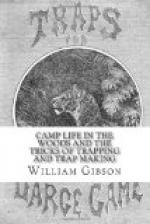To secure the cover in place a small tin catch should now be applied to the front edge of the box, as shown in the illustration. A piece of tin two inches in length by a half an inch in breadth will answer for this purpose. One end should be bent [Page 89] down half an inch at a pretty sharp angle, and the other attached by two tacks, to the edge of the box, in the position shown in the cut. This precaution will effectually prevent the escape of whatever bird, large or small, the trap may chance to secure. It is a necessary feature of the trap, as without it the elastics might be torn asunder and the lid thereby easily raised.
[Illustration]
This trap may be baited in a variety of ways. As it is particularly designed for a bird trap, it is well to sprinkle the bottom of the box with berries, bird-seed, small insects, such as crickets, grasshoppers, etc. These latter are very apt to jump out, and it may be well to fasten one or two of them to the bottom with a pin through the body, just behind the head.
There are many kinds of birds which live almost exclusively on insects; and as this bait is of rather a lively kind, there is scarcely any other method to retain them in their position. A bird on approaching this trap will almost irresistibly alight on the perch, and if not at first, it is generally sure to do so before long. If desired, a pasteboard platform may be fastened on the [Page 90] top of the perch with small tacks, and the bait scattered upon it. This will act in the same manner, and might, perhaps, be a trifle more certain. We will leave it to our readers to experiment upon.
We have given this variety the name of “owl-trap,” because it may be used with success in this direction. When set for this purpose, it should be baited with a live mouse, small rat or bird, either fastened to the bottom of the trap, if a bird, or set in with the trap inclosing it, if a mouse. A small bird is the preferable bait, as it may be easily fastened to the bottom of the box by a string, and as a general thing is more sure to attract the attention of the owl by its chirping.
The trap should be set in an open, conspicuous spot, in the neighborhood where the owls in the night are heard to “hoot.” The chances are that the box will contain an owl on the following morning.




